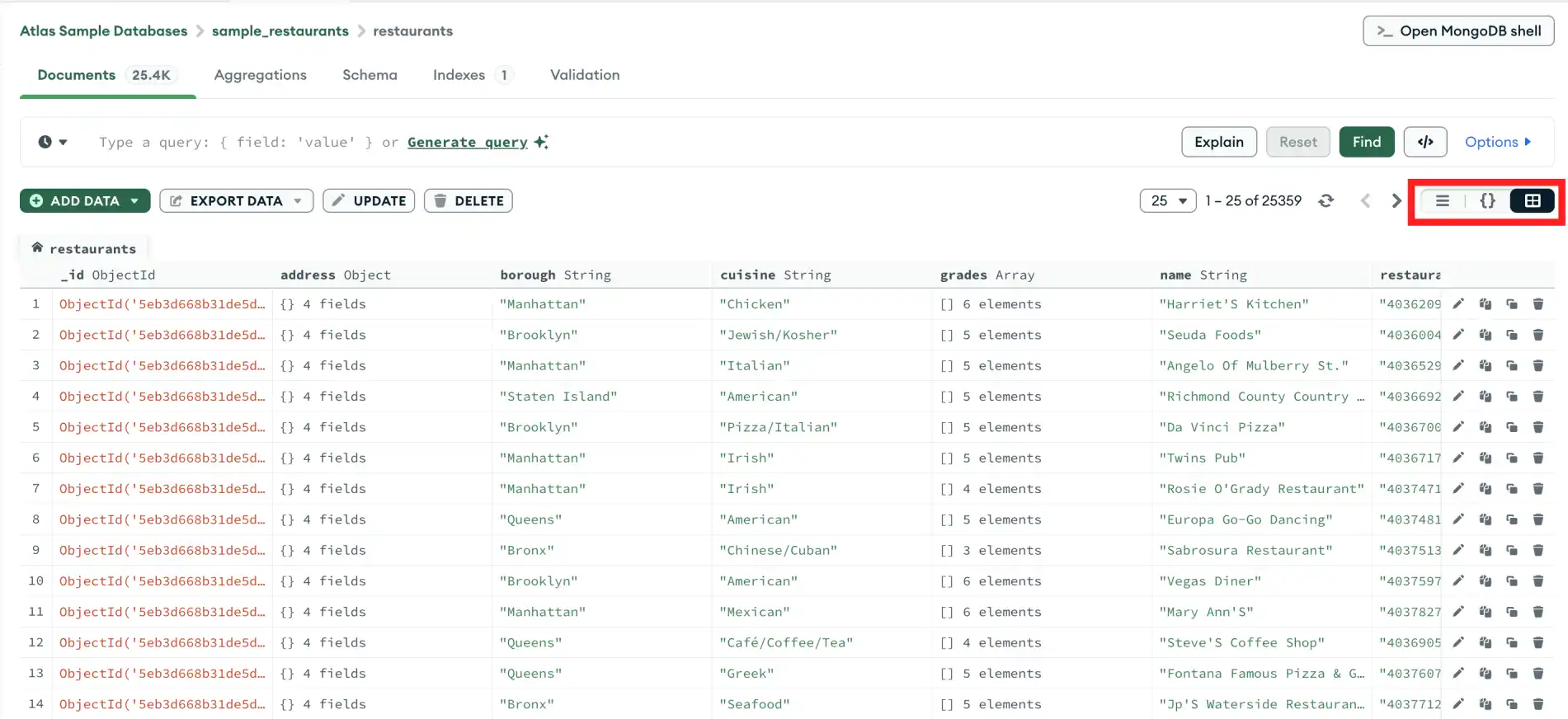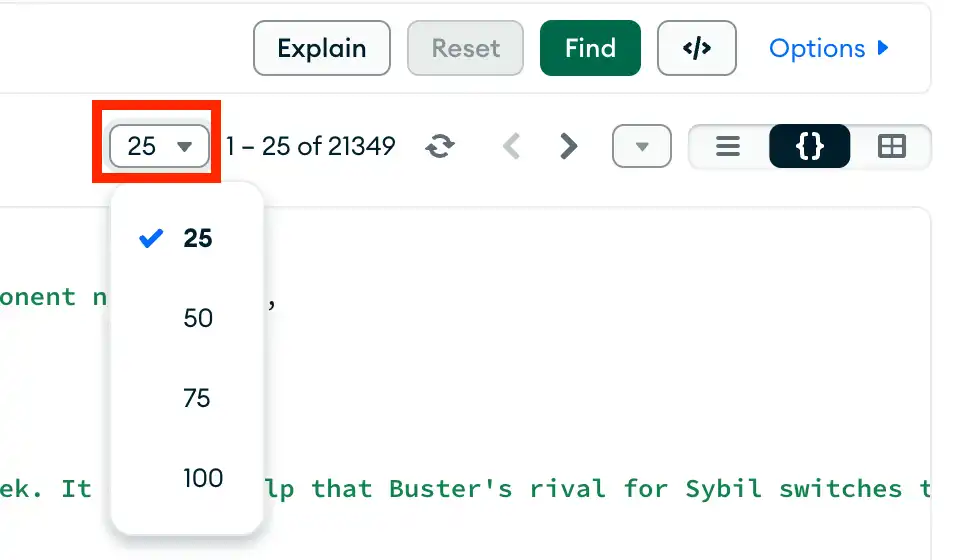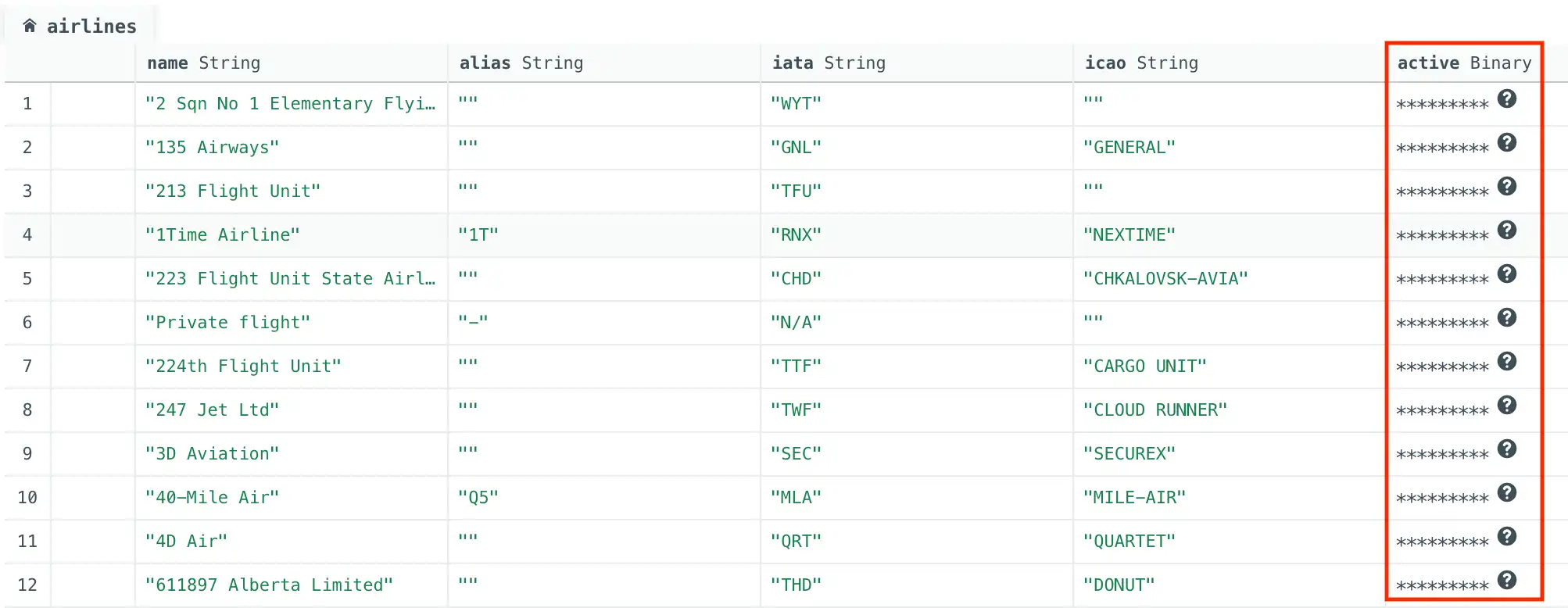The Documents tab provides three ways to access documents:
- List View
- The default document view. Documents are shown as individual members of a list. In this view you can easily expand embedded objects and arrays.
- JSON View
- Documents are shown as properly-formatted JSON objects. In this view Compass uses extended JSON to display the data types of fields where appropriate.
- Table View
- Shows documents as rows of a table, with document fields shown in the table columns. With this view, you can more easily see which documents contain specific field values.
Use the View buttons to select which view is shown in the following examples:


You can reorder the table columns by clicking and dragging the column headings. Reordering the columns is a strictly cosmetic change and does not change the underlying data itself.

By default, the Documents tab in Compass displays 25 documents at a time. To change the number of displayed documents per page, open the drop-down menu under the query bar and select one of the following values:
25
50
75
100

Note
If you change the number of documents displayed per page, Compass saves the new value as the new default, including when you open the Documents view in a new tab or after you restart Compass.
Expand Embedded Objects and Arrays
To expand all objects in all documents in your collection in List View or JSON View, you can right-click the query bar or its surrounding whitespace. Then, select Expand all documents from the drop-down menu.
Alternatively, you can open the drop-down arrow next to view selector and click Expand all documents.

Expand Individual Documents
To expand individual documents, follow the instructions below.
To toggle the expansion of embedded objects and array elements, hover over the target document and click the arrow in the top-left corner.

Alternatively, you can right-click on the document you want to expand and select Expand all fields from the drop-down menu.
To toggle the expansion of embedded objects and array elements, hover over the target document and click the top arrow on the left side of the document.
To expand individual objects and arrays, click the arrow to the left of the desired field.

Alternatively, you can right-click on the document you want to expand and select Expand all fields from the drop-down menu.
To view nested object fields and array elements, hover your cursor
over a field with a value type of Object or Array and
click the button with outward-pointing arrows which appears on the
right side of the field.
Compass opens a new tab in the Table View corresponding to the nested element.

The following example displays the address
object nested within the restaurants collection documents. The
new tab displays the five properties of the address object:

To return to the original table display, click on the first tab in the Table View which displays the name of your collection.
Copy Documents to Clipboard
To copy a document to your clipboard, hover over the document and click the Copy icon:

You can also right-click on the document and select Copy document from the drop-down menu.
Additionally, if you right-click a specific field or value, you can copy that field/value pair by selecting Copy field & value from the drop-down menu.
To copy a document to your clipboard, hover over the document and click the Copy icon:

You can also right-click on the document and select Copy document from the drop-down menu.
To copy a document to your clipboard, hover over the document and click the Copy icon:

Encrypted Fields
Compass obscures document fields encrypted with Field-Level Encryption (FLE). Compass displays the values of these fields as a series of asterisks.

If your deployment is connected using In-Use Encryption and your collection is configured with Queryable Encryption, you can toggle the In-Use Encryption connection option.
When In-Use Encryption is enabled, you can modify and view the encrypted values and fields.
When In-Use Encryption is disabled, Compass displays the values of these fields as a series of asterisks.
Compass obscures document fields encrypted with Field-Level Encryption (FLE). Compass displays the values of these fields as a series of asterisks.
If your deployment is connected using In-Use Encryption and your collection is configured with Queryable Encryption, you can toggle the In-Use Encryption connection option.
When In-Use Encryption is enabled, you can modify and view the encrypted values and fields.
When In-Use Encryption is disabled, Compass displays the values of these fields as a series of asterisks.
Compass obscures document fields encrypted with Field-Level Encryption (FLE). Compass displays the values of these fields as a series of asterisks.

If your deployment is connected using In-Use Encryption and your collection is configured with Queryable Encryption, you can toggle the In-Use Encryption connection option.
When In-Use Encryption is enabled, you can modify and view the encrypted values and fields.
When In-Use Encryption is disabled, Compass displays the values of these fields as a series of asterisks.
View URLs in Browser
If your document contains a URL value, you can right-click the URL and select Open URL in browser to open the URL in your browser:
